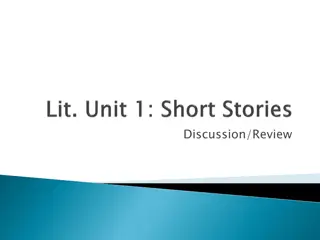Analyzing "The Most Dangerous Game" by Richard Connell
This analysis delves into the plot, conflict, and characterization in "The Most Dangerous Game" by Richard Connell. The story follows the intense rivalry between the protagonist, Rainsford, and the antagonist, Zaroff, on Ship-Trap Island. Through indirect characterization, Connell showcases Rainsford as a skilled hunter and someone who views hunting in a distinct light from Zaroff. Conversely, Zaroff is depicted as a formidable hunter with sinister traits. The story unfolds with a man vs. man conflict, ultimately leading to Rainsford outsmarting Zaroff in a deadly game of survival.
Download Presentation

Please find below an Image/Link to download the presentation.
The content on the website is provided AS IS for your information and personal use only. It may not be sold, licensed, or shared on other websites without obtaining consent from the author. Download presentation by click this link. If you encounter any issues during the download, it is possible that the publisher has removed the file from their server.
E N D
Presentation Transcript
THE MOST DANGEROUS GAME BY RICHARD CONNELL
The Most Dangerous Game on the Plot Diagram Rainsford reveals himself in Zaroff s bedroom. Rainsford escapes from Zaroff. Zaroff hunts Rainsford. Rainsford arrives on Ship-Trap Island. Rainsford and Zaroff face off. Setting: Ship-Trap Island Protagonist: Rainsford Antagonist: Zaroff Rainsford wins the game and kills Zaroff.
The Most Dangerous Game Conflict Man vs. Man The struggle of the story is between two men: Rainsford and Zaroff.
Characterization Characterization: the process by which the writer reveals the personality of a character. Direct characterization: an author overtly reveals a character s personality. Indirect characterization: textual clues show a character s motivation and intent. Connell uses indirect characterization to characterize Rainsford and Zaroff.
Indirect Characterization Rainsford Rainsford is indirectly characterized as an excellent hunter with the following details: He wrote a book about hunting. He recognizes the cartridge from the gun. He sets traps for Zaroff. He is the only one to survive Zaroff s game.
Indirect Characterization Rainsford Connell indirectly characterizes Rainsford as someone who doesn t view hunting animals as murder with the following details: He says animals don t understand fear. He says that Zaroff is a murderer because he hunts people.
Indirect CharacterizationZaroff Connell indirectly characterizes Zaroff as an excellent hunter with the following details: No one has survived his game. Hunting animals no longer challenges him. He reads books about hunting.
Indirect CharacterizationZaroff Connell indirectly characterizes Zaroff as evil or animalistic with the following details: He has thick black eyebrows and a pointed black moustache. He has dead, black eyes. He has a curious, red-lipped smile.
Mood Mood: the atmosphere of a literary work intended to evoke a certain emotion or feeling from the reader. The mood of The Most Dangerous Game is suspenseful. The name of the island is Ship-Trap Island, a place that sailors dread. Multiple references to darkness. The chase moves fast.
Point of view Point of view: the perspective, or outlook, from which a writer tells a story. The Most Dangerous Game is told from a third person limited point of view. Third person limited: centers on one character (Rainsford) and observes what he sees, hears, feels, or does.
Tone Tone: the attitude a writer takes toward the reader, a subject, or character. Connell s tone is straightforward and non-judgmental. He doesn t show preference toward Rainsford or Zaroff. He doesn t judge Zaroff or Rainsford. He doesn t offer comments or opinions on the story s events.
Foreshadowing Foreshadowing: hints or clues of events that have yet to occur. Clues in the story: Discussion of hunting on the yacht Ship-Trap Island Finding the bullet Big animal is unknown
Irony Irony: a contrast in expectations and reality. Verbal Irony: saying one thing but meaning another. Example: We do our best to preserve civilization here. Ironic because they are killing people for sport Situational Irony: an event occurs that contradicts the expectations of the reader. Dramatic Irony: the audience or the reader knows something that a character does not.
Imagery Imagery: language that appeals to the five senses: sight, smell, sound, taste, and touch. Imagery of darkness appears throughout The Most Dangerous Game. Example: The darkness pressed on his eyelids like a wet blanket. This statement appeals to the sense of touch and is a simile.
Allusion Allusion: a reference in a work of literature to a well-known character, place, or situation from literature, music, mythology, film, religion (especially the Bible), art, or history. Connell uses an allusion when you meet Zaroff: Then he sat down, took a drink of brandy from a silver flask, lit a cigarette, and hummed a bit from Madame Butterfly. Madame Butterfly is a famous opera.
Hyperbole Hyperbole: an extreme exaggeration. Example: Whitney suggests that even cannibals wouldn t live in such a God- forsaken place when talking about Ship-Trap Island. Example: Whitney says that Captain Nielsen would go up to the devil himself and ask him for a light.
Theme Theme is the central idea of a piece of literature. A possible theme of The Most Dangerous Game is in order to fully understand others, we must first walk in their shoes. Rainsford couldn t understand the animals he hunted until he was in their shoes.























